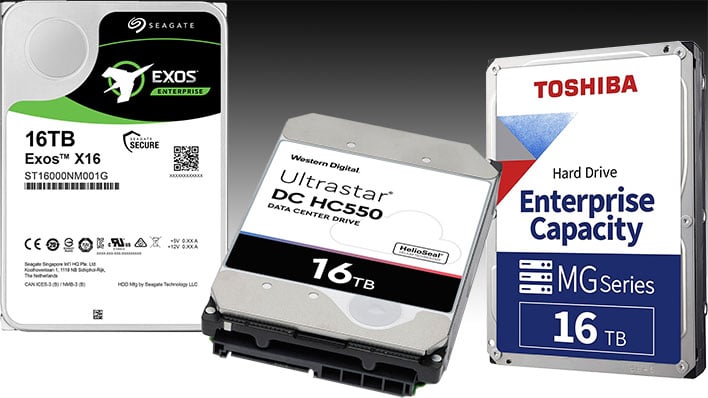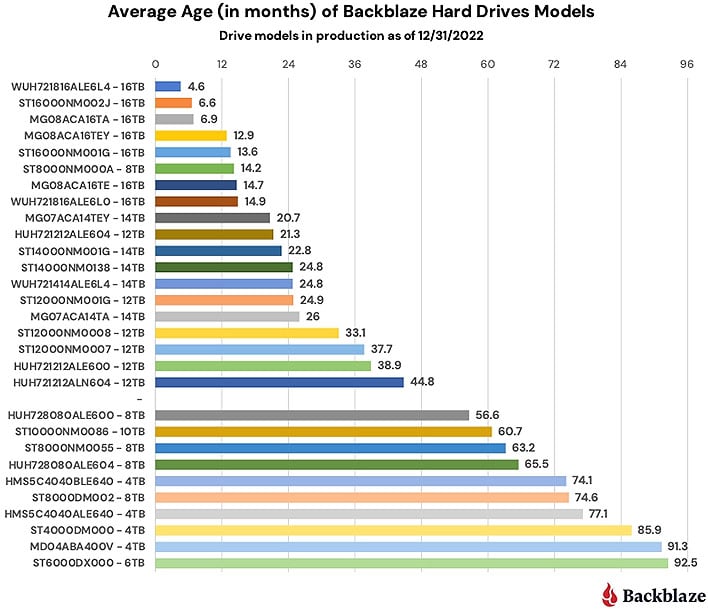Huge Capacity HDDs Shine In Latest Storage Reliability Report But There's A Caveat

When it comes to mechanical hard disk drive (HDDs), you'd be very hard pressed to find any data on failure rates reported by any of the major players, such as Western Digital, Seagate, and the rest. Fortunately for us stat nerds and anyone else who is curious, the folks at cloud backup firm Backblaze frequently issue reliability reports that give insight into the how often various models and capacities give up the ghost. At a glance, Backblaze's latest report highlights that bigger capacity drives—12TB, 14TB, and 16TB—fail less often than smaller capacity models. A closer examination, however, reveals that it's not so cut and dry.
Before we dive into the data, let's talk about these reports for a moment. They're imperfect examinations of the HDD scene as a whole as they don't include every specific model under the sun, and the ones that are included vary by quantity and length of deployment. Even so, it's one of the best general overviews available, as no other company we're aware of publishes this kind of info, at least to this degree.
So, what does today's report show? In a nutshell, Backblaze noted an overall rise in the annual failure rates (AFRs) for 2022. The cumulative AFR of all drives deployed rose to 1.37 percent, up from 1.01 percent in 2021.
By the end of 2022, Backblaze had 236,608 HDDs in service, including 231,309 data drives and 4,299 boot drives. Its latest report focuses on the data drives. The cloud backup firm notes that it removed 388 drives from consideration because they were either used for testing, or had less than 60 units in its fleet. That left it with 230,921 HDDs to include in the report.

Source: Backblaze
Looking at the data, Blackblaze notes that its fleet of 12TB and larger HDDs ended last year with an AFR of 1.07 percent. Meanwhile, its 10TB and smaller models ended the year with an AFR of 2.12 percent, essentially double that of the larger capacity models. Additionally, the outfit notes that while the "small drive cohort represents only 28.7 percent of the drive days in 2022, they account for 44.5 percent of the drive failures.

Source: Blackblaze
Bigger drives are more reliable than smaller drives, case close, right? Not so fast. There's an important caveat to this data—while the smaller drives failed more often last year, they are also older, as can be seen in the graph above.
"The aging of our fleet of hard drives does appear to be the most logical reason for the increased AFR in 2022. We could dig in further, but that is probably moot at this point. You see, we spent 2022 building out our presence in two new data centers, the Nautilus facility in Stockton, California and the CoreSite facility in Reston, Virginia. In 2023, our focus is expected to be on replacing our older drives with 16TB and larger hard drives," Backblaze says.
As for drive failures by brand, Seagate had the highest failure rate of the bunch. Again, though, there's a similar caveat—the Seagate models deployed are "significantly older" than every other brand (which includes HGST, Toshiba, and WDC). Backblaze also points out that there's a value proposition to consider.
"Before you throw your Seagate and Toshiba drives in the trash, you might want to consider the lifecycle cost of a given hard drive model versus its failure rate...For example, in general, Seagate drives are less expensive and their failure rates are typically higher in our environment. But, their failure rates are typically not high enough to make them less cost effective over their lifetime. You could make a good case that for us, many Seagate drive models are just as cost effective as more expensive drives," Backblaze states.
You can check out the full reliability report if you want to dive deeper into the numbers. The general takeaway, however, is that older drives fail more often than newer ones (duh, right?), and that bigger capacity models aren't showing any early signs of weakness. Regardless, your best bet is to make sure you keep multiple backups of your most critical and valuable data.

